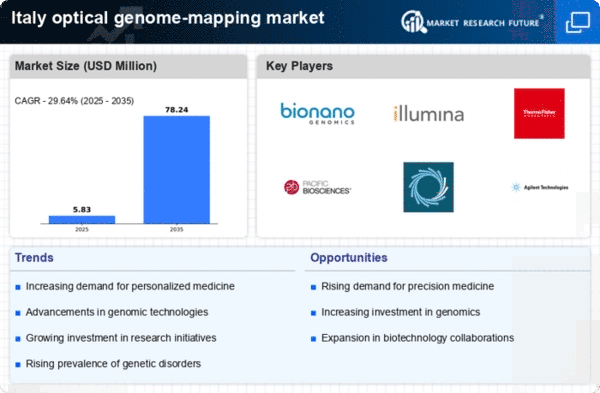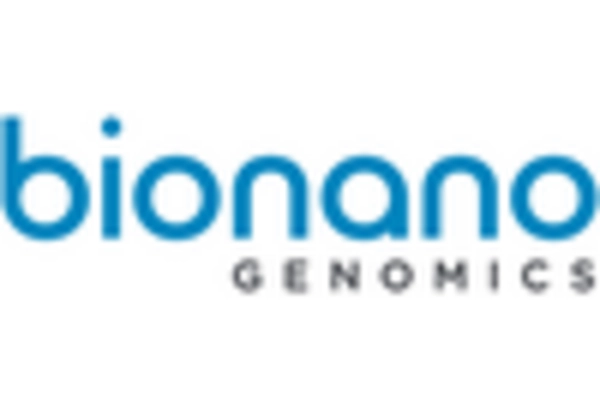Supportive Regulatory Environment
A supportive regulatory environment in Italy is contributing positively to the optical genome-mapping market. Regulatory bodies are increasingly recognizing the importance of genomic technologies in improving healthcare outcomes. This has led to the establishment of guidelines and frameworks that facilitate the approval and adoption of optical genome-mapping technologies. The Italian Medicines Agency (AIFA) has been proactive in streamlining the approval processes for genomic testing, which is likely to encourage more companies to enter the market. As regulations become more favorable, the optical genome-mapping market is expected to see an influx of innovative products and services. This supportive regulatory landscape not only enhances market confidence but also promotes investment in research and development, further driving the growth of the optical genome-mapping market in Italy.
Growing Awareness of Genetic Disorders
There is a rising awareness of genetic disorders among the Italian population, which is significantly impacting the optical genome-mapping market. As more individuals become informed about the implications of genetic conditions, the demand for comprehensive genomic testing is increasing. This heightened awareness is leading to a greater acceptance of optical genome mapping as a diagnostic tool. Healthcare providers are increasingly recommending genetic testing to identify predispositions to various diseases, thereby driving market growth. The optical genome-mapping market is expected to expand as more patients seek out these advanced diagnostic options. Additionally, educational campaigns and initiatives aimed at informing the public about genetic health are likely to further enhance the market's visibility and acceptance, ultimately contributing to its growth in Italy.
Rising Demand for Personalized Medicine
The optical genome-mapping market is experiencing a notable surge in demand for personalized medicine in Italy. This trend is driven by the increasing recognition of the importance of tailored treatments based on individual genetic profiles. As healthcare providers and patients alike seek more effective and targeted therapies, the optical genome-mapping market is positioned to play a crucial role. The market is projected to grow at a CAGR of approximately 15% over the next five years, reflecting the growing inclination towards precision medicine. Furthermore, advancements in optical genome mapping technologies enable clinicians to identify genetic variations that may influence treatment responses, thereby enhancing patient outcomes. This shift towards personalized healthcare is likely to propel the optical genome-mapping market forward, as it aligns with the broader goals of improving healthcare efficiency and effectiveness in Italy.
Increased Investment in Genomic Research
Investment in genomic research is a significant driver for the optical genome-mapping market in Italy. The Italian government and private sectors are increasingly allocating funds to genomic studies, recognizing their potential to revolutionize healthcare. In recent years, funding for genomic research has seen an increase of over 20%, indicating a robust commitment to advancing this field. This influx of capital supports the development of innovative optical genome-mapping technologies, which are essential for understanding complex genetic diseases. As research institutions and biotech companies collaborate to explore the human genome, the optical genome-mapping market is likely to benefit from enhanced research capabilities and technological advancements. The growing emphasis on genomic research not only fosters innovation but also positions Italy as a key player in the global genomic landscape, further stimulating the optical genome-mapping market.
Technological Integration in Healthcare Systems
The integration of advanced technologies into healthcare systems in Italy is fostering growth in the optical genome-mapping market. As hospitals and research institutions adopt cutting-edge technologies, the demand for innovative diagnostic tools, including optical genome mapping, is on the rise. This integration facilitates more efficient data management and analysis, allowing for quicker and more accurate genetic assessments. The optical genome-mapping market is likely to benefit from this trend, as healthcare providers seek to enhance their diagnostic capabilities. Furthermore, the collaboration between technology firms and healthcare providers is expected to lead to the development of more sophisticated optical genome-mapping solutions, thereby improving patient care. The ongoing digital transformation in healthcare is a key driver for the optical genome-mapping market, as it aligns with the broader goals of enhancing healthcare delivery and outcomes.

















Leave a Comment